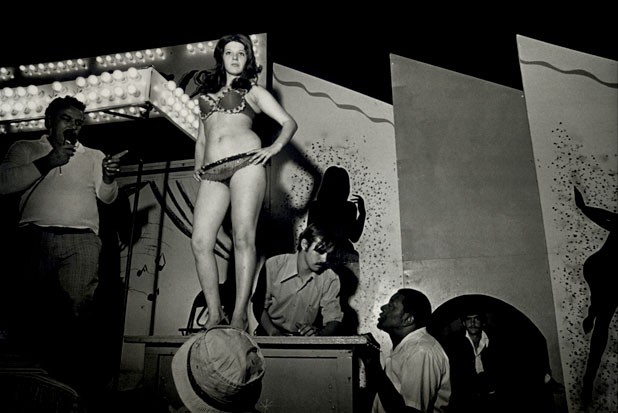
- "Lena on the Bally Box," Essex Junction, 1973
More than three decades after they were taken, Susan Meiselas’ photos of strippers at Vermont county fairs retain their power to shock. But while these images reveal plenty of female flesh, they don’t transmit much of an erotic charge. The bigger shock for Vermonters viewing the photos — on display at the International Center of Photography (ICP) in Manhattan — may come from learning that such scenes were once common at county fairs all over the state, including the Champlain Valley Fair in Essex.
“They appealed to unsophisticated rural men,” recalls Tom Slayton, editor emeritus of Vermont Life magazine. “Folks would come down from the hills to see a girlie show and then talk about it for the rest of the year.”
The Champlain Valley Fair may not be entirely wholesome today, but there are no longer women in g-strings and pasties posing at the entrance to tents as barkers beckon men to step inside. In the mid-1970s, however, Meiselas took hundreds of girlie-show shots at the fair in Essex, as well as in Tunbridge, Barton and other stops along the New England carnival circuit.
A selection is included in her book Carnival Strippers, originally published in 1976 and reissued in 2003. Photos taken mainly at fairs in Vermont also fill one of the rooms in her career retrospective, entitled “Susan Meiselas: In History,” which remains on view at ICP through January 4.
For three consecutive summers, Meiselas recorded women gyrating on stage and relaxing backstage, often wearing even less than they did when performing. The grainy black-and-white photos convey a tawdry and melancholy mood; the women appear lonely and disengaged even when surrounded by mobs of leering men.
Meiselas says she was able to gain access to the men-only shows and to the women’s dressing quarters by gradually winning the trust of strippers and managers alike. “They found it curious that someone wanted to get to know them, took an interest in what they were doing.”
As a 24-year-old with degrees from Sarah Lawrence and Harvard, Meiselas had come upon the girlie shows in the course of “wandering around the world looking for interesting things to photograph.” Having been raised in suburban New York, she says she was “fascinated by a rich cultural experience I never could have imagined.” What startled her most back then, Meiselas remembers, was “the everyday quality of what the women were doing. It was just a job.”
It was the series of girlie-show pictures that gained Meiselas membership in Magnum Photos, a co-op agency that has been the outlet for some of the greatest photo-journalists of the 20th century. She was on assignment for Magnum in Nicaragua during the 1980s when she chronicled the Sandinista uprising and subsequent counterrevolutionary war. These dramatic combat shots form the core of the ICP show, along with Meiselas’ later photo documentation of Kurdish culture.
She returned to Vermont in 2002 as a new edition of Carnival Strippers was being readied for the presses. Much had changed. “I couldn’t find anyone who admitted going to those shows back then,” Meiselas says. The difference in attitudes, she suggests, might have been partly attributable to the influx of feminists into Vermont as part of the hippie migration of the late ’60s and ’70s.
Much has also not changed, Meiselas observes. “There’s a different façade to the sex industry now. Porn has become very commercialized. Now there’s lap-dancing clubs, and the kind of women performing may be different from in the carnivals. But I see it as a continuum.”









Comments
Comments are closed.
From 2014-2020, Seven Days allowed readers to comment on all stories posted on our website. While we've appreciated the suggestions and insights, right now Seven Days is prioritizing our core mission — producing high-quality, responsible local journalism — over moderating online debates between readers.
To criticize, correct or praise our reporting, please send us a letter to the editor or send us a tip. We’ll check it out and report the results.
Online comments may return when we have better tech tools for managing them. Thanks for reading.